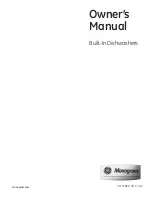
SETT ING UP YO UR NEW WA SHI NG MAC H I N E
3 - BEFORE FIRST USE
Caution: Never operate your washing machine unless it contains enough water
•
Place the machine in a sink or on a shower base and make sure the drain hole on the right under the tub is not obstructed. Check
that the drain water will not splash outside the sink or shower.
•
Make sure the washer unit is correctly installed. Both pins on the front of the rotor plate should be inserted in the corresponding
notches.
•
Connect the fill hose (E) on the inlet (Drawing 2) located next to the drain handle (4). Place the end-fitting (F) on the other end of the
hose (See drawing 3).
•
Place the motor unit on the tub. Make sure the drive gear (18) from the motor shaft is inserted in the drive shaft funnel (19). Check
also that both pegs at the back (20) and the tab at the front (21) are inserted in the corresponding holes in the tub (See drawing 3).
Model 50.40
•
Insert the three prongs (23) into the motor unit connector (22). You will need to push against the back of the motor unit to slide on
the connector (See drawing 4).
4 - PREPARING LAUNDRY
U S E
5 - WATER TEMPERATURE
•
Sort clothes according to colour and type of fabric.
For example separate them into different loads:
- delicate fabric and wool,
- white and colourfast fabrics,
- non-colourfast fabrics.
Thick white and colourfast fabric should be soaked before
washing in the machine.
•
Your machine is designed to wash up to 2 kg of laundry. We
have listed the approximate weights of typical laundry items
below to help you determine the correct quantity per load:
•
1
Handkerchief ........................................................ 25 to 50 g
•
1
Pair of socks or briefs ............................................ 50 to 75 g
•
1
T-shirt, small face towel or child's pinafore .......... 75 to 100 g
•
1
Dishcloth, bathroom towel or child's dress
and pinafore .......................................................... 100 to 150 g
•
1
Cotton blouse, dinner napkin or night-gown ...... 150 to 200 g
•
1
Man's shirt, child's pyjamas or large
bath towel .............................................................. 200 to 300 g
•
1
Woman's overalls .............................................. 300 to 400 g
•
1
Man's pyjamas or large cotton overalls ............ 400 to 500 g
•
1
Small (160 x 160 cm) linen tablecloth .............. 500 to 600 g
•
1
Man's overalls or work cloths ............................ 600 to 700 g
Remember that very dirty clothes will need two full wash cycles.
•
You can add water at any temperature (including boiling water)
to your washing machine unless you have a Model 50.40. In that
case, add cold water only.
Water temperature should be selected based on the type of
fibres in the laundry to be washed and on the instructions printed
on your box of laundry detergent.
•
Model 50.40 - Tropical Heated Model
The water heater system can heat wash water to between
about 20°C and 60°C.
1 - Select the wash water temperature based on the
instructions on the control panel:
30°C for delicate fabrics and wool
40°C for delicate colours and synthetics
60°C for colourfast and resistant synthetics
Heating water to 60°C will take from 30 minutes, for minimum
water volume, to about 50 minutes, for maximum water
volume.
2 - If you feel that the water temperature is high enough, just
switch off the heater.
Safety: the floater will interrupt heater power if the water level
in the tub is too low. The temperature controller in the heater
(5) will keep temperature from exceeding 70°C if you forget to
turn off the heater.



































